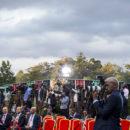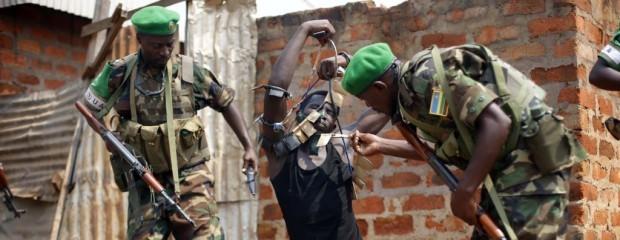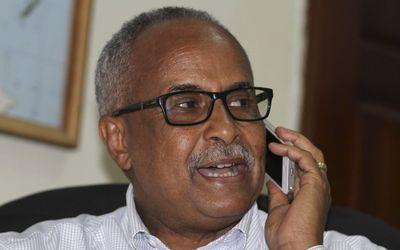Understanding Darfur’s Arab Militia
A new report from the Small Arms Survey by Julie Flint, “Beyond Janjaweed: Understanding the Militias of Darfur,” examines the Arab militia in Darfur, through the stages of mobilization, mutiny and their current dance of distrust with the Khartoum authorities.
Julie Flint’s report is the first extended description and analysis of the Arab militia in the public sphere. It is based on field research over an extended period. It is unequalled. This posting is drawn from the summary.
Six years after Darfurians drawn largely from non-Arab tribes declared themselves in rebellion, Sudan’s westernmost region is a confusion of armed enclaves and seemingly intractable conflicts. The Government’s writ runs only in the towns, and even there its control is being challenged by the militias it armed to fight the rebels in 2003.
The number of violent deaths in Darfur is much reduced and the multi-fronted government-militia offensives that set Darfur ablaze in 2003-04 have given way to a new pattern of periods of relative calm with spikes of violence. About one third of the violent fatalities in 2008 and early 2009 were people killed in intra-Arab clashes aimed at securing land and authority. The militias have taken on a life of their own. They feel betrayed by the Darfur Peace Agreement (DPA), which did not address the concerns and needs of their tribes, and no longer trust the Government to represent their interests in any forum.
Darfur has drifted beyond government authority. Excluded from most forms of international action on Darfur most of the time and collectively demonized as “˜janjaweed’, a word coined to describe common criminals within their own communities, Darfur’s Arabs are attempting to find a voice of their own and a forum in which to address the economic fragility, social neglect and lack of security that helped push them into the arms of the Government in the first place.
The causes of the conflict are complex and deeply-rooted, involving perceived political and economic marginalisation, failing institutions (especially security institutions), environmental degradation and population pressure, and ubiquity of small arms as a result of regional conflicts and open, uncontrollable borders. A “˜racial’ dimension introduced to the conflict in the 1980s, to support an ideology based on “˜Arab’ supremacy, has sharpened into an ethnic divide in which the militias are predominantly pastoralists claiming an Arab identity and the rebels predominantly settled, or semi-settled, communities self-identified as “˜Africans’.
The Arab pastoralists who formed the spearhead of the government’s counterinsurgency campaign””primarily the landless Northern Rizeigat””were impoverished before the insurgency. A system whereby nomadic tribes not assigned land of their own had customary rights to land and water along transhumant routes began to break down in the 1980s and collapsed in many areas in the 2000s, as rebellion brewed. Pastoralists have seen their livelihoods further damaged by the devastation they helped bring about””increased obstacles to pastoral migration, loss of markets, schools and clinics, and the destruction of the symbiotic relationship between herder and farmer. Militia salaries have become a coping mechanism, even a badge of honour for some poor communities.
Failing to find an ear for their grievances and finding difficulty in forming alliances or finding patrons away from the Government, in part because of their human rights abuses, Darfur’s militias are in the throes of a process of fragmentation that parallels that of the rebel movements. Government officials privately acknowledge that they are unable to control the militias, except through more money and more weapons. But they lack a long-term strategy to restore order in Darfur, and isolated attempts to impose control are undercut by continuing impunity and short-termism dictated by military need””especially in the face of the new firepower of the Justice and Equality Movement (JEM), which now demands regime change.
Based on fieldwork in North and South Darfur, the report is not a comprehensive account of the scores of tribal militias that have been armed by, or cooperated with, the Government in its counterinsurgency campaign. Its subject is not the human rights violations that have accompanied the counterinsurgency. Rather it aims to disentangle the militias and begin to understand their motivations and grievances. Key findings include the following:
“¢ The Government’s mobilisation of tribal militias to fight the insurgency was a well-established pattern, in large part a reflection of the weakness of the professional army after two decades of purges and corrupting civil war, faced with a rebellion using new and unfamiliar tactics of mobile warfare.
“¢ The key factors leading tribal leaders to join the government’s counter-insurgency did not include “˜racial’ identity. They were land and cash. When the Government appealed for recruits, landless Arab groups saw an opportunity to expand their access to land and, by extension, local authority and political power. Tribes with land attempted to remain neutral. Government cash payments rented loyalty.
“¢ Because their situation was less critical than that of the hundreds of thousands of villagers who were forced off their lands, and because their human rights violations were so egregious, there has been little international contact with the tribes involved in the counterinsurgency and almost no attempt to analyse their motivation. There is little understanding of why they took up arms””and what is needed to convince them to put them down.
“¢ Nomads are familiar only with small arms. Only those integrated into paramilitary forces like the Border Guards or Central Reserve Police had training in, and access to, heavy weapons.
“¢ Repeated calls on the Government to disarm the “˜janjaweed’ have ignored the plurality of the militias and their motives, and wildly overestimated the Government’s ability to control its proxies. Timeframes, beginning with the 30-day deadline set by the UN Security Council in July 2004, have been unrealistic and undeliverable. The Government has made no serious attempt to act on its promises to disarm or restrict the militias. Short-term military needs repeatedly undermine any effort to enforce command and control.
“¢ Although ethnicity has been manipulated by all parties to the conflict, and ethnic lines have been sharpened by depiction of the conflict as a “˜genocidal’ war against “˜Africans’, local politics trumps “˜racial’ identity, especially when the Government takes a back seat and neighbours with long histories of co-existence sit down to settle their differences.
“¢ Militia leaders have pursued their own agendas and have manipulated the government to their advantage. Always undisciplined””in fact encouraged to be undisciplined by the promise of loot””the militias are generally agreed to be beyond the control either of the government or, in some cases, the tribal leadership of the Native Administration.
“¢ The nomadic pastoralists who form the backbone of the militias have a long tradition of fighting to protect their migration routes and, when necessary, force their way to pastureland and water. Fearing bloody reprisals by their victims, they believe today that keeping their weapons is more than ever necessary to their survival.
The report proceeds by tracing the mobilisation of militias in 2004, the frustration among the government’s proxies with the Darfur Peace Agreement (DPA) of 2006, and the slow-burning rebellion that culminated at the end of 2007 with the mutiny of the strongest Border Guard leader, Mohamed Hamdan Dogolo “˜Hemeti’. The so-called “˜janjaweed’ are the empty quarter of reporting and analysis of Darfur. Their needs and motivation need in-depth scrutiny and understanding if Darfur is to reach a peace.







This research certainly fills a very important gap in the developments following 2003-04 spree of violence in Darfur. As conflicts have a dynamic of their own, which as they unfold change shape and direction, so does the definitions of victims and perpetrators. However as most peace agreements are drawn over the past events (with talks often spread over a relatively long period, during which new developments emerge, and which inturn are left largely unadressed in the proceedings) they often end up being inadequate in adressing the needs of all parties concerned.
Disarmament becomes a complicated issue, rare success stories coming from West Africa on guns-for-cash programs, however largely unresolved in regions such as Western Europe: splinter groups stemming from original militia movements running territorial warfare taking the “troubles” one step further from internal conflict to gang-wars.
When sitting down to construct a peace agreement with offshoots in regional development and reconstruction (as well as resettlement) all these and more need to be kept in consideration, with working papers such as this proving to be invaluable.
Complete disarmament is chimerical.
For one thing, Flint is correct: the Sudanese security forces are powerless to stop the Janjaweed, some of whom rioted in al-Fasher in April 2008 when the government failed to provide timely wages. Reportedly, police and troops were unable to stem the looting – in spite of the fact that the city is a major staging area for counter-insurgency operations, and thus militarily important to the regime. The government’s interest in acting against the Janjaweed will only wane from here on in: they have too much at stake in the south to want to devote more resources to implementing the DPA or something like it.
Meanwhile, automatic small arms have been a fact of life in Darfur since about the 1970s. Joanna Spear urges attention to the fact that weapons may become embedded in certain societies where they have obtained social and economic significance – as markers of status, or means of physical security and income-generation. Disarmament must therefore move ahead on the basis of “sensitive” responses tailored to the status quo ante, rather than a theoretical optimum, however appealing.
Moreover, Darfur is practically awash with firearms. Jan Pronk was apparently once treated to a parade of Janjaweed fighters who turned over as many as five or six rifles apiece, yet always retaining one for themselves. An April 2007 report of the SAS describes Sudan as both a point-of-origin and transfer site for small arms heading to Central Africa and the nearby Horn, while the supply of domestic man-portable light weapons is anywhere between 1.9 and 3.2 million, of which 66% are in private possession, 20% are in government hands, and the balance is held by “current and former armed groups.†The Survey observed that transit of small arms is facilitated by “longstanding migratory patterns†and the weakness of security organs, which are open to both depredation and the lure of selling their own equipment to obtain private income. Customs activity is confined to the three urban centers, while the Border Guards have become a dumping ground for militiamen loyal to the government.
De Waal has identified a number of potentially useful policies briefed to DPA parties, but never fully fleshed out, such as registry of gun owners to “a specified authority,†limitations on militia movement, and “gradual†enactment of legal or normative restraints on public employment (in addition to a host of military capacity-building, liaison, and reconciliation mechanisms for the groups themselves, above and beyond individual obligations). These arguably constitute the most practical steps forward, since hierarchies of responsibility speak to presumptive power: those who answer for the men with guns are themselves certain to be “big men.” Heavy and crew-served weapons can be cantoned, under AU/UN guard. Nobody is asking for heavy machine guns; they just want the guarantee of a rifle.